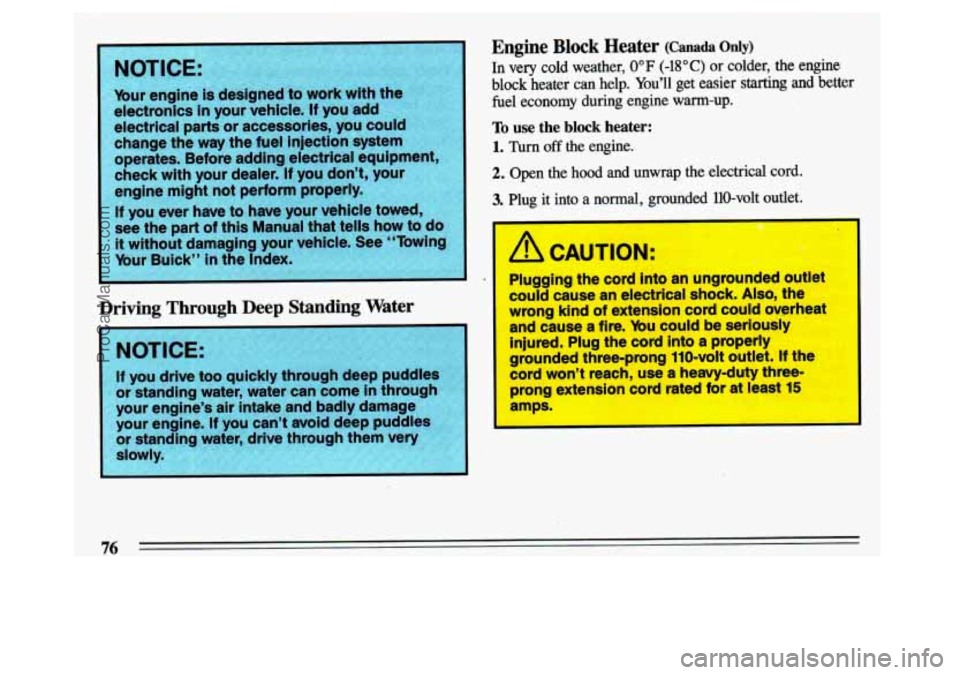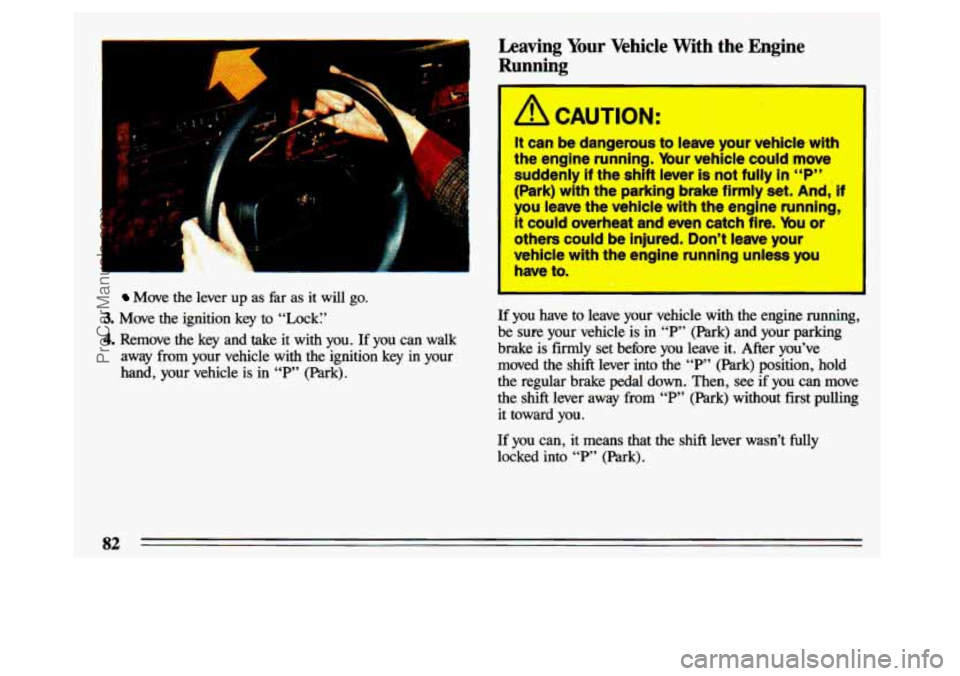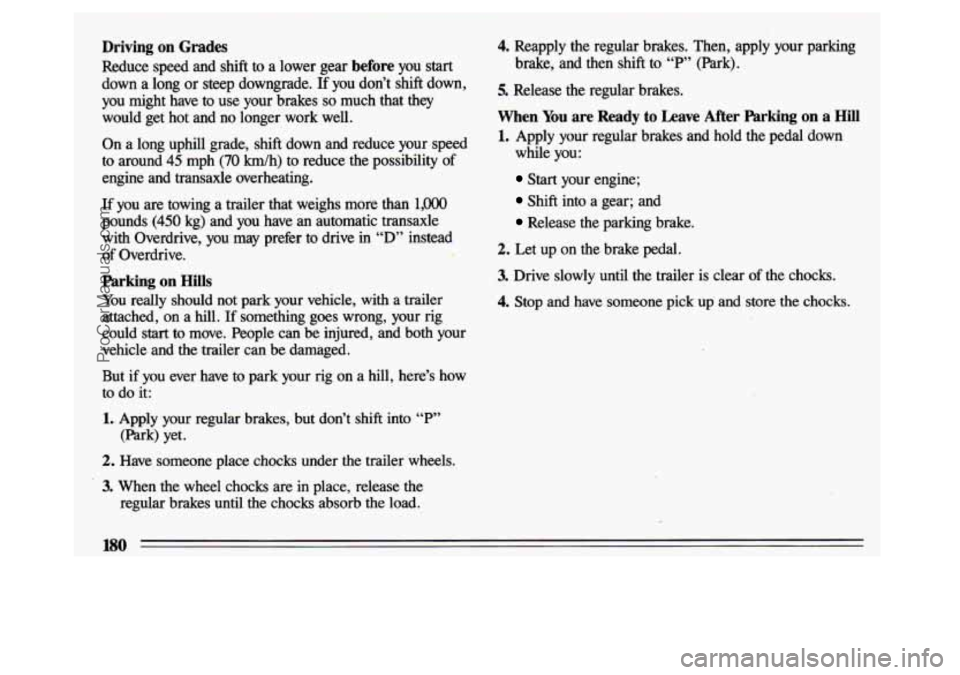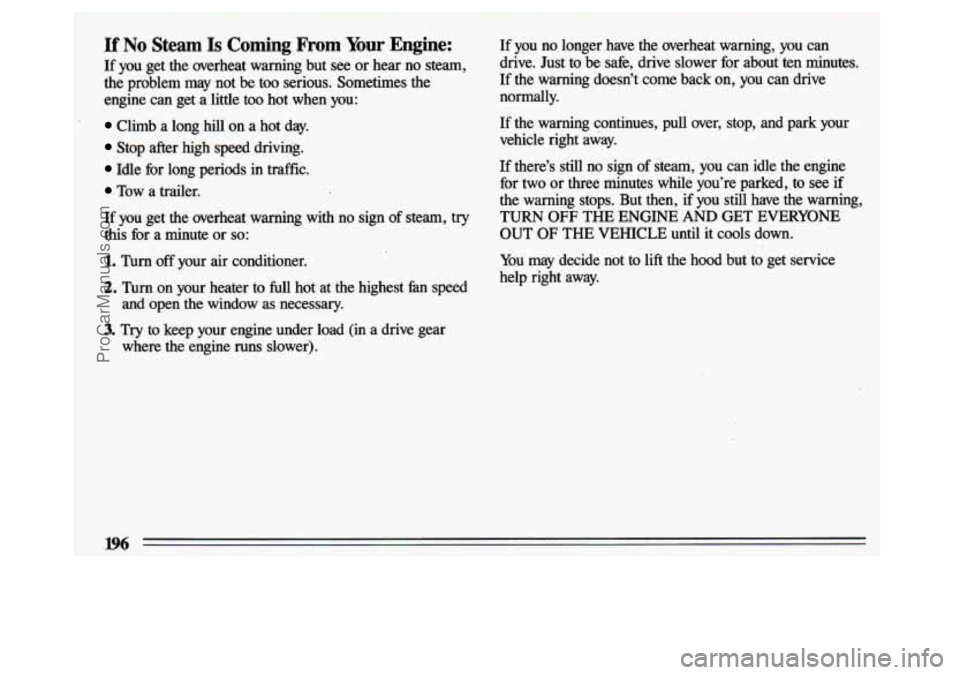1993 BUICK CENTURY engine overheat
[x] Cancel search: engine overheatPage 11 of 324

Table of Contents
Introduction How to Use this Manual ....................................................... .10
This part tells you how to use your manual and includes safety and vehicle damage warnings\
and symbols.
Part 1 Seats and Safety Belts .......................................................... I3
This part tells you how to use your seats and safety belts properly.
Part 2 Features & Controls .......................................................... .63
Part 3 Comfort Controls & Audio Systems. ............................................. W!
Part 4 Your Driving and the Road. .......................... : ........................ .I33
Part 5 Problems on the Road. ....................................................... .l83
Part 6 Service & Appearance Care .................................................... .221
Part7MaintenanceSchedule ...........................................................
Part 8 Customer .Assistance Information .............................................. .299
This part explains how to start and operate your Buick.
This part tells you how to adjust the ventilation and comfort controls and how
to operate your sound system.
Here you’ll find helpful information and tips about the road and \
how to drive under different conditions.
This part tells you what to
do if you have a problem while driving, such as a flat tire or engine overheating.
Here the manual tells you how to keep your Buick running properly and looking good.
This part tells you when
to perform vehicle maintenance and what fluids and lubricants to use.
This part tells
you how to contact Buick for assistance and how to get service publications. It also gives you information
on “Reporting Safety Defects on page 302.”
hrt9Index ......................................................~...............30\
7
Here’s an alphabetical listing of almost every subject in this manual. You can use it to quickly find something you want
to read.
ProCarManuals.com
Page 78 of 324

~ Driving T -ough Deep Standing Water
orktanding
water, water can come in through
your engine’s air intake and badly damage your en ine. If ou can’t avoid dee uddles
or stan
slowly.
Engine Block Heatel lada only)
In very cold weather, 0°F (-HOC) or colder, the engine
block
heater can help. You’ll get easier starting and better
fuel economy during engine warm-up.
To use the block heater:
1. Turn off the engine.
2. Open the hood and unwrap the electrical cord.
3. Plug it into a normal, grounded UC olt outlet.
I I
Plugging the cord into an ungrounded outlet I
could cause an electrical shock. Also, the
wrong kind of extension cord could overheat
and cause a fire.
You could be seriously
injured. Plug the cord into a properly
grounded three-prong 110-volt outlet.
If the
cord won’t reach, use a heavy-duty three-
prong extension cord rated for at least 15
amps.
ProCarManuals.com
Page 84 of 324

F- LA- 1
Move the lever up as far as it will go.
3. Move the ignition key to “Lock:’
4. Remove the key and take it with you. If you can walk
away from your vehicle with the ignition key in your
hand, your vehicle is
in “P” (Park).
Leaving Your Vehicle With the Engine
Running
It can be dangerous to leave your vehicle with
the engine running. Your vehicle could move
suddenly if the shift lever is not fully in
“P”
(Park) with the parking brake firmly set. And, if
you leave the vehicle with the engine running,
it could overheat and even catch fire. Ybu or
others could be injured. Don’t leave your
vehicle with the engine running unless you
have to.
If you have to leave your vehicle with the engine running,
be sure your vehicle
is in “P” (Park) and your parking
brake is firmly set before you leave it. After you’ve
moved the shift lever into
the “P” (Park) position, hold
the regular brake pedal down. Then, see if you can move
the shift lever away from
“P” (Park) without first pulling
it toward you.
If you can, it means that the shift lever wasn’t hlly
locked into
“P’ (Park).
82
ProCarManuals.com
Page 112 of 324

A CAUTION:
Your brake system may not be working properly
if the brake warning light is on.
Driving with the brake warning light on can
lead to an accident.
If the light is still on after
you’ve pulled
off the road and stopped
carefully, have the vehicle towed
for service.
Engine Coolant Temperature Warning Light
---I
This light tells you that
your engine coolant has
overheated or your radiator
cooling
fan is not working.
If you have been operating
your vehicle under normal
driving conditions, you should pull
off the road,
stop your vehicle and
turn
the engine off as soon as
possible.
HOT COOLANT CAN
BURN YOU BADLY!
In “Problems on the Road:’ this manual shows what to
do. See “Engine Overheating” in the Index.
Engine Coolant Temperature Gage (Option)
‘1 If you have the Gage
Cluster, you have a gage
that shows the engine
coolant temperature.
If the
gage pointer moves into the red area, your engine is too
hot! That reading means the same thing as the warning
light. It means that your engine coolant has
overheated. If you have
been operating your vehicle under normal driving
conditions, you should pull off the road, stop your-
vehicle and
turn off the engine as soon as possible.
Also, the temperature symbol on the gage will come on
when your engine is too hot.
HOT COOLANT CAN BURN YOU BADLY!
In “Problems on the Road:’ this manual shows what to
do. See “Engine Overheating” in the Index.
110
ProCarManuals.com
Page 182 of 324

Driving on Grades
Reduce speed and shift to a lower gear before you start
down a long or steep downgrade. If you don’t shift down,
you might have to use your brakes
so much that they
would get hot and no longer work well.
On a long uphill grade, shift down and reduce your speed
to around
45 mph (70 Mh) to reduce the possibility of
engine and transaxle overheating.
If you are towing a trailer that weighs more than 1,OOO
pounds (450 kg) and you have an automatic transaxle
with Overdrive, you may prefer
to drive in “D” instead
of Overdrive.
Parking on Hills
You really should not park your vehicle, with a trailer
attached, on a hill.
If something goes wrong, your rig
could
start to move. People can be injured, and both your
vehicle and the trailer can be damaged.
But if you ever have to park your rig on a hill, here’s how
to do it:
1. Apply your regular brakes, but don’t shift into “P”
2. Have someone place chocks under the trailer wheels. (Park) yet.
3. When the wheel chocks
are in place, release the
regular brakes until the chocks absorb the load.
4. Reapply the regular brakes. Then, apply your parking
5. Release the regular brakes.
When You are Ready to Leave After Parking on a Hill
1. Apply your regular brakes and hold the pedal down
brake, and then shift to
“P” (Park).
while you:
Start your engine;
Shift into a gear; and
Release the parking brake.
2. Let up on the brake pedal.
3. Drive slowly until the trailer is clear of the chocks.
4. Stop and have someone pick up and store the chocks.
ProCarManuals.com
Page 185 of 324

I
Here you’ll find what to do about some problems that can occur on the road.
Part 5 includes:
HazardWarningFlashers ..............................................................184
Other Warning Devices . . . . . . . . . . . . . . . . . . . . . . . . . . . . . . . . . . . . . . . . . . . . . . . . . . . . . . . . . . . . . . .185
Jumpstarting
........................................................................\
..
Towing Your Buick . . . . . . . . . . . . . . . . . . . . . . . . . . . . . . . . . . . . . . . . . . . . . . . . . . . . . . . . . . . . . . . . . . .189
Engine Overheating
. . . . . . . . . . . . . . . . . . . . . . . . . . . . . . . . . . . . . . . . . . . . . . . . . . . . . . . . . . . . . . . . . .195
IfaTireGoesFlat
...................................................................205
ChangingaFlatTire ........................................,........................205
CompactSpareTire ..................................................................218
If You’re Stuck: In Sand, Mud, Ice or Snow . . . . . . . . . . . . . . . . . . . . . . . . . . . . . . . . . . . . . . . . . . . . . . .219
ProCarManuals.com
Page 197 of 324

Engine Overheating
You will find a coolant temperature gage or the warning
light about a hot engine on your Buick’s instrument panel. A CAUTION:
Steam from an overheated engine can burn
you badly, even if you
just open the hood. Stay
away from the engine if you see
or hear steam
coming from
it. Just turn it off and get
everyone away from the vehicle until
it cools
down. Wait
until there is no sign of steam or
coolant before opening the hood.
If you keep driving when your engine is
overheated, the liquids
in it can catch fire. You -w others could be badly burned. Stop your
~gine if
it overheats, and get out of the
vehicle until the engine is cool.
195
ProCarManuals.com
Page 198 of 324

If No Steam Is Coming From Your-Engine:
If you get the overheat warning but see or hear no steam,
the problem
may not be too serious. Sometimes the
engine can get a little too hot when you:
Climb a long hill on a hot day.
Stop after high speed driving.
Idle for long periods in traffic.
Tow a trailer.
If you get the overheat warning with
no sign of steam, try
this for a minute or so:
1. Turn off your air conditioner.
2. Turn on your heater to full hot at the highest fan speed
and open the window as necessary.
3. Try to keep your engine under load (in a drive gear
where the engine runs slower). If you no longer have the overheat warning, you can
drive. Just to be safe, drive slower for about ten minutes.
If the warning doesn’t come back on, you can drive
normally.
If the warning continues, pull over, stop, and park your
vehicle right away.
If there’s still no sign of steam, you can idle the engine\
for two or three minutes while you’re parked, to
see if
the warning stops. But then, if you still have the warning,
TURN OFF THE ENGRVE AND GET EVERYONE
OUT
OF THE VEHICLE until it cools down.
You may decide
not to lift the hood but to get service
help right away.
ProCarManuals.com